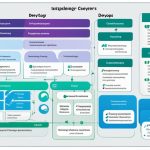Cloud analytics tools have revolutionized the way organizations extract meaningful insights from their cloud networks. By combining data analytics with cloud computing infrastructure, businesses can harness the power of big data to optimize operations and drive strategic decision-making. Through this approach, organizations gain valuable cloud network insights that can give them a competitive edge in today’s fast-paced digital landscape.
In this article, we will explore the world of cloud analytics and its impact on businesses. From understanding the technological framework behind cloud analytics to uncovering its key benefits and guiding you in choosing the right platform, we will provide you with the essential knowledge needed to leverage cloud analytics for success.
Stay tuned as we delve into the realm of cloud analytics and discover how it can transform your business.
Understanding Cloud Analytics: A Technologically Advanced Framework
Cloud analytics operates within a cloud computing framework, utilizing virtual servers distributed across the internet. Data from diverse sources, such as sales databases and social media streams, is transmitted to these cloud servers for storage and subsequent analysis. Data models are created to organize the data, allowing for efficient querying and extraction of insights. Trained professionals use advanced tools and software to analyze the data and uncover patterns, trends, and anomalies. This analytical phase transforms raw data into actionable insights. The scalability of cloud platforms enables organizations to adjust computational resources as needed, minimizing costs and facilitating the analysis of big data.
Advantages of Cloud Analytics:
- Efficient storage and analysis of data from various sources.
- Creation of data models for organized querying.
- Utilization of advanced tools and software for data analysis.
- Identification of patterns, trends, and anomalies.
- Transformation of raw data into actionable insights.
- Scalability to adapt computational resources to data volume.
“Cloud analytics empowers organizations to extract meaningful insights from their vast and complex datasets, driving informed decision-making and business growth.”
Common Data Models Used in Cloud Analytics:
| Data Model | Description |
|---|---|
| Relational Model | Organizes data into tables with defined relationships between entities. |
| Hierarchical Model | Represents data in tree-like structures with parent-child relationships. |
| Star Schema Model | Consists of a central fact table connected to dimension tables, enabling efficient querying. |
| Graph Model | Utilizes nodes and edges to represent complex relationships between data entities. |
Key Benefits of Cloud Analytics for Business Growth
Cloud analytics offers several benefits for businesses. The flexible architecture of cloud-based infrastructures allows organizations to adjust resources based on data processing needs, optimizing performance and cost reduction. With improved data sharing and collaboration capabilities, teams can work together on data-intensive projects regardless of their physical locations, leading to enhanced teamwork and faster decision-making. The pay-as-you-go pricing model further reduces costs by only charging for resources actively utilized.
One of the key advantages of cloud analytics is data democratization. It enables data-driven insights for everyone in the organization, irrespective of their technical expertise. By making data accessible and understandable, cloud analytics empowers employees to make informed decisions and contribute to business growth.
In addition to these benefits, cloud platforms prioritize data security. Robust measures are in place to protect sensitive information and ensure compliance with regulations. This ensures that businesses can leverage the benefits of cloud analytics without compromising data integrity or jeopardizing their security.
Overall, cloud analytics provides organizations with the tools and capabilities to unlock the power of data for business growth. The flexibility, improved data sharing, cost reduction, data democratization, and data security offered by cloud analytics make it a valuable asset for organizations seeking to enhance their decision-making capabilities and gain a competitive edge.

| Benefits | Description |
|---|---|
| Flexible Architecture | The ability to adjust resources based on data processing needs, optimizing performance and reducing costs. |
| Improved Data Sharing | Enhanced collaboration and teamwork on data-intensive projects, regardless of physical locations. |
| Cost Reduction | The pay-as-you-go pricing model ensures costs are incurred only for actively utilized resources. |
| Data Democratization | Enabling data-driven insights for everyone in the organization, regardless of technical expertise. |
| Data Security | Robust measures in place to protect sensitive information and ensure compliance with regulations. |
Choosing the Right Cloud Analytics Platform
When it comes to selecting a cloud analytics platform, organizations must carefully consider various factors to ensure they make the right choice. By evaluating aspects such as flexibility, cost, ease of use, scalability, integration, and security and compliance, businesses can find a platform that aligns with their unique data requirements and analysis tasks.
Flexibility: The chosen platform should offer the flexibility to adapt to changing business needs and data-processing requirements. This ensures that organizations can scale their analytics capabilities as their data volumes grow and their analytical needs evolve.
Cost: Cost is an essential consideration, but it goes beyond the upfront expenses. Organizations should evaluate the long-term affordability of the platform and the value of insights it delivers. This involves assessing the platform’s pricing model, subscription options, and any additional costs associated with usage and support.
Ease of Use: An intuitive and user-friendly interface plays a significant role in the platform’s efficiency. The platform should be easy to navigate and operate, minimizing the learning curve for users. Compatibility with existing tools and systems also contributes to a seamless integration within the organization’s analytics ecosystem.
Scalability: As data volumes continue to increase exponentially, it is crucial to select a platform that can scale effortlessly. Organizations should opt for a platform that can handle large amounts of data without compromising performance, ensuring smooth operations even during peak activity periods.
Integration: Seamless integration with other cloud services and existing analytical tools is vital for maximizing the platform’s capabilities. The chosen platform should enable smooth data transfers and allow for efficient collaboration among various teams and departments.
Security and Compliance: Protecting sensitive data and ensuring compliance with regulations is of utmost importance. Organizations must choose a platform that offers robust security measures, including data encryption, access controls, and regular audits. Compliance with industry-specific regulations should also be a key consideration.
To sum up, selecting the right cloud analytics platform requires a careful evaluation of various factors. By considering flexibility, cost, ease of use, scalability, integration, and security and compliance, organizations can make an informed decision that aligns with their data analytics needs and contributes to business growth.
Conclusion
Cloud analytics is revolutionizing data analysis and empowering organizations to harness the potential of cloud computing and advanced analytics tools. By utilizing cloud analytics, businesses can unlock valuable insights, make accurate predictions, and drive strategic decision-making. The benefits of cloud analytics, including flexibility, cost efficiency, data democratization, and enhanced security, make it an indispensable tool for maximizing the potential of cloud networks.
By carefully selecting the right cloud analytics platform and leveraging its capabilities, organizations can transform their data into actionable insights and propel business growth. Cloud analytics enables businesses to adapt to changing market dynamics, identify trends, and drive innovation. It empowers decision-makers with the knowledge needed to optimize operations, improve customer experiences, and stay ahead of the competition.
In the era of digital transformation, data analysis is a crucial component of business success. Cloud analytics provides the infrastructure and tools necessary to extract meaningful insights from vast amounts of data. It facilitates informed decision-making, enables organizations to identify opportunities and challenges, and facilitates strategic planning. Embracing cloud analytics is the key to unlocking the full potential of data and driving business transformation in the modern landscape.
FAQ
What is cloud analytics?
Cloud analytics is an approach that combines data analytics with cloud computing infrastructure to process and analyze large amounts of data. It offers flexibility, scalability, and resources to organizations, enabling them to make more informed decisions and gain a competitive edge in their industries.
How does cloud analytics work?
Cloud analytics operates within a cloud computing framework, utilizing virtual servers distributed across the internet. Data from diverse sources is transmitted to these cloud servers for storage and subsequent analysis. Data models are created to organize the data, allowing for efficient querying and extraction of insights. Trained professionals use advanced tools and software to analyze the data and uncover patterns, trends, and anomalies. This analytical phase transforms raw data into actionable insights.
What are the benefits of cloud analytics for businesses?
Cloud analytics offers several benefits for businesses. It provides flexibility in adjusting resources based on data processing needs, optimizing performance and cost-effectiveness. Improved data sharing and collaboration capabilities enable teams to work together on data-intensive projects, regardless of their physical locations. The pay-as-you-go pricing model reduces costs by charging only for actively utilized resources. Cloud analytics also democratizes data access, making data-driven insights possible for everyone in the organization. Additionally, cloud platforms prioritize data security, offering robust measures to protect sensitive information and ensure compliance with regulations.
What factors should I consider when choosing a cloud analytics platform?
When selecting a cloud analytics platform, it’s important to consider factors such as flexibility, cost, ease of use, scalability, integration, and security and compliance. The platform should align with the unique data requirements and analysis tasks of the organization. Cost should be evaluated not only based on the upfront expenses but also the long-term affordability and value of insights delivered. The platform’s ease of use and compatibility with existing tools and systems will impact the learning curve and overall efficiency. Scalability ensures that the platform can handle increasing data volumes without compromising performance. Integration with other cloud services and strong security measures are also crucial considerations.
How can cloud analytics help businesses transform their data?
By harnessing cloud analytics, businesses can unlock actionable insights, make accurate predictions, and drive strategic decision-making. The benefits of cloud analytics, such as flexibility, cost efficiency, data democratization, and enhanced security, make it a valuable tool for unlocking the potential of cloud networks. By choosing the right cloud analytics platform and leveraging its capabilities, organizations can transform their data into actionable insights and drive business growth.



















